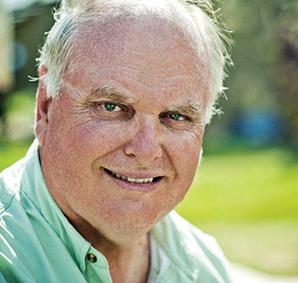Gaylon White
Published: September 23, 2013 1:00 pm ET
Updated: September 23, 2013 1:07 pm ET

Image By: Alan Lee
Gaylon White
I was 12 years old when my dream of playing major league baseball was shattered. Clark Moseley, a talented 10-year-old, replaced me as the starting first baseman for the Norwood Village Little League Dodgers. If I was going to get to first base in the future, I had to find something else I could do.
I started my professional career as a sportswriter and, then, got into the corporate world, writing speeches for top executives. As I struggled to stay awake during one meeting, a colleague slipped me a note:
There once was a fellow of the press
Whose first love was sports,
he'd confess
Now why he got into enterprise
To work for the highest of the highs,
Is as much his as anyone's guess.
The author of this ode went on to become a president for a major tire company. I wound up bouncing from one company to another until, much to my surprise, I found myself breaking bread with industrial designers — a relatively small group of people who come up with ideas for products and packaging, gravitate toward black attire and see things differently than most folks. We had a lot in common, especially when I started wearing black shirts.
For starters, we share a love for stories and their power to inform and inspire. Designer Yves Behar likes to say, "Design brings stories to life." He even trademarked the quote and made it a guiding principle for his trend-setting consultancy, fuseproject.
Maybe it's the way they think and dress but designers are often misunderstood by engineers, scientists and business types more concerned with their next promotion than the next great innovation. For all the talk about breakthrough innovation, most companies lack the resolve and patience to achieve it.
Richard Seymour, co-founder of Seymourpowell, a London-based design firm, calls this "the violence of the new." The typical client response, Seymour says, is: "No, no, I can't cope with that idea. I know I've asked for something new but I can't cope with that."
Lincoln Seragini is known in Brazil as the "Jedi Master of Design" for his ability to integrate marketing, engineering and design. He was a chemical engineer before he got into packaging development and marketing.
"You have to dream the impossible," Seragini says. "So creativity — the dream — comes first. Engineering is trained to say, 'No, it's not possible.' And it isn't possible if you develop a project linearly — one portion after another. You have to bring engineers and designers together and establish a synergy where creativity is tops."
That's the holy grail — harnessing the power of design and R&D at the start of a project. Engineers pride themselves on being good problem solvers, as are designers. But they approach a problem from an entirely different perspective. Bringing the disciplines together early on can result in a solution neither would have come up with on their own.
After making a design presentation in Brazil, a cosmetics company executive shared what he called the three C's of creativity: curiosity, culture and courage. I added two C's — collaboration and champion — and featured them in future seminars. All are essential but at the top is collaboration.
Today's multidimensional challenges are too big for even the biggest of companies to go it alone. The marketplace is too fast-paced and complex for any R&D group to keep up with on its own. R&D and design should be joined together at the hip, sharing the same bloodstream.
"Design thinking is a term used by designers to help companies understand the relevance of the creative process in shifting perspectives to achieve higher levels of innovation through ideation and collaborative methodologies," explains Joan Gregor, founder and CEO of Intersection-Inc., a San Diego strategic design firm. "Design thinking is very cerebral and certainly a good tool. But we need to get it out of our head and into our consciousness. It is only then that designing with empathy and from the users' perspective is truly embraced, embodied and integrated into an organization's process."
Every company has its technology orphans, ideas that R&D came up with but can't find a home for in the marketplace. What if designers looked at these orphans through new eyes, empathetic with the needs and desires of users?
Art Fry, a 3M Co. scientist, adopted an orphan to create Post-it notes. He wanted to make a bookmark that would stick to paper. Copolymer microspheres discovered several years earlier by a colleague made it possible.
"We're all working under a street lamp," Fry says. "We're acquainted with everything under the light and using it in every possible way. And, then, somebody goes out into the darkness and drags back something we haven't seen before. The thing that keeps the whole process going is what's out there in the darkness — what we don't know about."
Fry makes a strong case for design when he says: "You have to depend upon the pioneer type that leaves the clan, goes out, climbs down the cliff, fords the river, explores the land on the other side, builds a rope bridge across, comes back and says, 'There's a great new territory over there.' You need the type that doesn't fly in formation."
Nobody ever accused designers of flying in formation. Challenging the status quo, trying the untried and stepping into the darkness is what designers do best.
Shortly after Clark Moseley pushed me off of first base in Little League, I discovered I turned a phrase better than I hit a curveball. I set my sights on becoming another Jim Murray, Pulitzer Prize-winning sports columnist for the Los Angeles Times and king of the one-liners: "Show me a man who is a good loser and I'll show you a man who is playing golf with his boss." But the Murray quote that's inscribed in an old scrapbook is this one: "There's a story in every man. The challenge is to find it. Then the problem is to tell it without putting the reader to sleep."
My goal with this column is to search every nook and cranny of the manufacturing and design worlds to find and tell compelling stories that keep you awake until the end.
Incidentally, Moseley didn't make it to the big leagues either. I wish he had because it would be a better story. | 